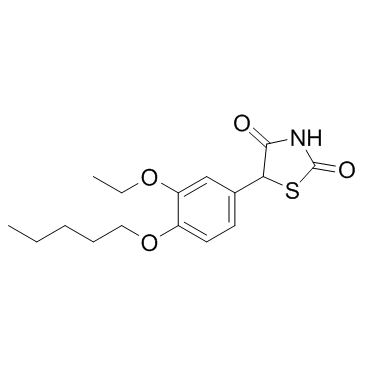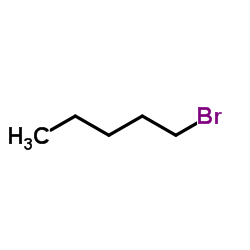79714-31-1
| Name | 5-(3-ethoxy-4-n-pentyloxyphenyl)thiazolidine-2,4-dione |
|---|---|
| Synonyms | RISARESTAT |
| Description | Risarestat (CT-112), an aldose reductase inhibitor, is developed for the treatment of diabetic complications. |
|---|---|
| Related Catalog | |
| In Vivo | Risarestat inhibits the accumulation of dulcitol in a dose-dependent manner, except for the 1.0% solution which has an activity comparable to the 0.25% solution[1]. Risarestat peaks in the corneal epithelium, stroma, endothelium and aqueous humor in 30 minutes following instillation, then gradually diminishes time-dependently over a period of 24 hours. Risarestat remains detectable in the lens up to 24 hours, with a peak concentration at 2 hours after instillation[2]. The anterior surface area of superficial cells in the group treated with Risarestat is significantly decreases from a mean value of 881 to 728 microns2. Corneal sensitivity significantly improves from 5.36 to 1.37 g/mm2[3]. Animals treated with Risarestat shows a significant increase in the mean blinkresponse compared to untreated galactose-fed rats and does not differ significantly from controls towards the completion of the 7 month study. Animals treated topically with Risarestat and untreated galactose-fed rats develop bilateral nuclear cataracts within 3 weeks[4]. |
| Animal Admin | Rats: The other 5 groups are fed on a 50% galactose diet, and 0.1, 0.25, 0.5 or 1.0% Risarestat ophthalmic solution or its vehicle is instilled in both eyes 4 times a day in each of the 5 treated groups. After 2 weeks, the corneal epithelium is scraped off in all rats and its dulcitol content is determined by gas chromatography[1]. Rabbits: Risarestat is prepared in acetate-buffered saline. 50 μL of 0.5% Risarestat in 7mM acetate-buffered saline (pH 5.2, 290 mOsm) containing 0.15% chlorbutanol as a preservative is instilled to both conjunctival sac of rabbits. This ophthalmic solution is proven to be untoxic to the external eye after 90 days' instillation to the rabbits 9 times a day. The rabbits are then sacrificed at, 15 and 30 minutes, 1, 2, 4, 8, and 24 hours after instillation[2]. |
| References |
| Molecular Formula | C16H21NO4S |
|---|---|
| Molecular Weight | 323.40700 |
| Exact Mass | 323.11900 |
| PSA | 89.93000 |
| LogP | 4.00720 |
| Storage condition | 2-8℃ |
|
~% 
79714-31-1 |
| Literature: Sohda; Mizuno; Imamiya; Tawada; Meguro; Kawamatsu; Yamamoto Chemical and Pharmaceutical Bulletin, 1982 , vol. 30, # 10 p. 3601 - 3616 |
| Precursor 1 | |
|---|---|
| DownStream 0 | |
